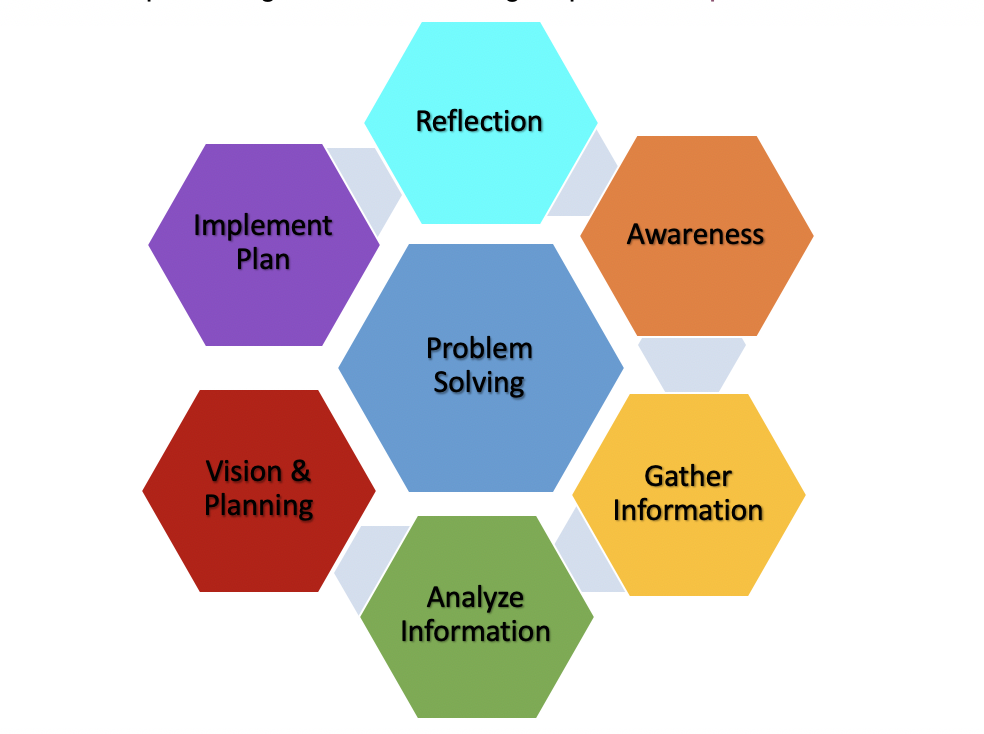As a school leader for more than 15 years, having the ability to quickly problem solve while including my team has been a vital craft to develop. I’m Abby Woods, a longtime leader in schools working alongside teams to improve educational experiences for students. My current role, besides being a board member for CREATE, is as the Director of Internal Consulting for Charleston County School District.

The problem-solving wheel graphic has been an essential tool for my school teams to attack educational issues related to student achievement and program evaluation. Many times teams gather to admire the problem and often get derailed with discussing the issues rather than prioritizing the solution through a process of performance measures and documentation.
Lessons Learned:
- Ensure your team can stay focused on the issues at hand and encourage them to be specific with problem. For example, the literacy program is not working is vague; whereas gathering information and creating a ‘work flow’ of the literacy process will help identify the breakdown.
- Providing stakeholders with an outline or steps helps the team feel successful in problem solving. Additionally, the cogs of the wheel can be assigned, then brought back to share for further examination. Teacher teams feel especially empowered through this level of responsibility and problem-solving for their students.
- Guiding the team through this problem-solving wheel requires a systematic approach giving each member a role. Put differently, the ‘buy-in’ of the team will grow as the leader develops responsibility within the team.
Rad Resources:
- American Evaluation Association is a great resource for leaders to evaluate how your team is growing. https://www.eval.org/page/competencies
- The Flippen Group has a myriad of resources for growing, developing and stabilizing teams. These were practices that are most helpful when creating the appropriate culture for team growth and problem solving. https://flippengroup.com/capturing-kids-hearts/
- The Racial Equity Institute provided an incredible insight and tools for evaluation as leaders work in a variety of organizations.
The American Evaluation Association is celebrating Consortium for Research on Educational Assessment and Teaching (CREATE) week. The contributions all this week to aea365 come from members of CREATE. Do you have questions, concerns, kudos, or content to extend this aea365 contribution? Please add them in the comments section for this post on the aea365 webpage so that we may enrich our community of practice. Would you like to submit an aea365 Tip? Please send a note of interest to aea365@eval.org. aea365 is sponsored by the American Evaluation Association and provides a Tip-a-Day by and for evaluators.

I am a student in the PME program at Queens University, in Kingston Ontario and am currently taking a course in Program Inquiry and Evaluation. I connected to your article as soon as I saw the “problem solving” wheel. As an instructional lead at my school, I can also see how this wheel would come in very handy to evaluate programs.
I have led many PLC’s and we have taken on the Collaborative Inquiry model and follow the work of Jennifer Donohoo. This wheel and this model I have mentioned, have many similarities. Every stage of this wheel and the collaborative inquiry model are similar in that the contain the stages of problem solving (reflection), inquiry (awareness, gather information), collaboration (analyze information, vision and planning) and design (implement plan). Both of these models or processes allow stakeholders the ability to collaborate and through their inquires come up with a central idea or overall problem they need to try and solve by designing and implementing plans to meet their students learning needs.
I appreciate that although the collaborative model is very systematic, it is not linear, and teams may need to go back and forth on the cycle. I would imagine this problem-solving wheel would be the same and participants would have the ability to go back and forth depending on any challenges the evaluation may pose. When I have facilitated inquiry teams, we brainstorm ideas, frame our problem and decide upon a common goal but after analyzing data we realize that we may need to take a step or two back and that the problem runs a little deeper than we thought. (i.e.: set a school goal of improving students reading fluency when after analyzing reading records realized that accuracy was the overall underlying issue and thus had to change our goal and focus.)
I appreciate the three points you made as I also agree that participants need a systematic approach, with every member serving a specific purpose, clearly defined goals, which everyone agrees upon and are working towards and a clearly defined process to keep everyone motivated and on track.
I wonder about any challenges you may face when evaluating programs and working collaboratively with a team. I wonder how you have overcome these challenges. I also have found that if success is not found after a certain amount of time, participants may lose interest in the end goal. Do you have any advice for keeping members motivated to continue and complete the program evaluation using this problem-solving wheel?
I appreciated the link provided to the “performance measures and documentation” and look forward to sharing this with my team at work as I think it will help guide our evaluation questions.